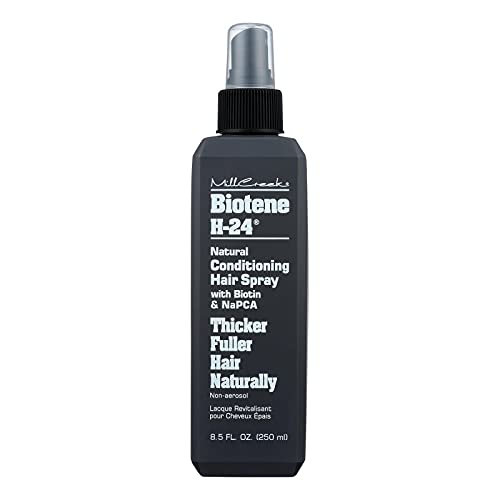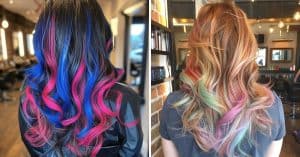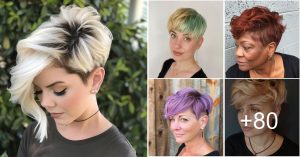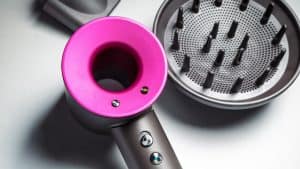Whether you're new to using hairspray or it's been part of your long-time hairstyling routine, you may be wondering whether you can wash it out with water. After all, hairspray is designed to keep your hair in place, so is it really as easy as just rinsing it out? Well, we've done the research and have an answer for you.
Hairspray does wash out with water. Fortunately, removing hairspray from your hair is generally pretty easy. If you don't have many tangles in your hair, you don't even have to use water to remove it. You should be able to remove the hairspray by brushing it out. However, if you use hairspray frequently, your hair may experience product buildup, which requires more work to remove.
So water can remove hairspray, but is it the best method? Keep reading as we discuss ways you can remove hairspray from your hair. We'll also answer some other questions you might have about removing hairspray and whether you have to wash it out.
![A hairdresser spraying hair of customer, Does Hairspray Wash Out With Water? [And Other Ways To Remove It]](https://stylecheer.com/wp-content/uploads/2021/08/Does-Hairspray-Wash-Out-With-Water--683x1024.png)
This article may include affiliate links and elements that were carefully created by our team using advanced ai to help you envision the best style advice.
Removing Hairspray
Hairspray has evolved over the years. In years past, hairspray was known for leaving hair stiff and crunchy after it's applied. Now, newer brands and products can achieve the same look without stiffness. Hairspray works by creating polymers that coat the hair bonding them in place. So, whether you have used hairspray that has left your hair feeling crunchy or not, you still need to remove it to keep your hair fresh and healthy.
Washing Out Hairspray
Hairspray can be rinsed out, but if your hair has become matted or tangled from the product, you might need to wash your hair. Though you might typically shampoo your hair before conditioning, for knots entangled with hairspray, you should condition first.
Apply a generous amount of conditioner to your hair and work it through the tangles. This will help gently untangle your hair. Once you've got as many tangles out as you can, shampoo and condition your hair once more per your usual hair care routine.
For hair that isn't tangled but has a lot of hairspray in it, you can try rinsing your hair with water or just following your regular wash routine.
How do you get hairspray out of your hair without washing it?
Washing your hair can be a chore, and if you have already washed your hair earlier that day, you might be hesitant to rewash it. Fortunately, you don't always have to wash your hair to remove hairspray. Here are two methods you can try to remove hairspray that doesn't involve washing your hair:
Brush or Comb
Hairspray will typically just brush out. You can take a comb or a hairbrush and brush the product out, and your hair should feel almost, if not exactly, how it did before you applied it. If you had a firm hold hairspray, you should notice a difference after brushing. Whether brushing out hairspray is a good option for you depends on how much you've used. If you have too much hairspray in your hair and you try to brush it out, it may cause your hair to break.
Detangler Spray
Another way to remove hairspray involves using detangler spray. Detangler spray doesn't have to be washed out, so you can use it to remove hairspray. Spray the detangler over your hair, and using a towel, gently wipe away the hairspray by using a scrunching motion. The stylist in the video below recommends Johnson's Detangling spray, but your favorite brand should work too.
Check out this YouTube video from a hairstylist on how to use a detangler spray to remove hairspray:
Click here to see Johnson's No More Tangles Spray Detangler on Amazon.
Do you have to wash your hairspray out?
Maybe you got home late from a night out, and you just want to crash in bed, but for whatever reason, you just don't feel like dealing with your hair right now. If you don't want to wash the hairspray out or even brush it away, you may be wondering if it's ok to just leave it in your hair overnight until you can deal with it in the morning.
Not washing hairspray out once or twice won't harm your hair too much, but don't make it a habit. Hairspray, especially if a lot was applied, can cause your hair to dry out, so it's best to wash it off or brush it out as soon as you are done. A small amount of hairspray will do little to any damage to your hair, and sleeping will cause some of it to come out anyway.
However, you should also consider your skin. If you don't wash hairspray out, it can clog your pores and irritate your skin or scalp. It's not just the skin on your head that could become clogged. If you go to bed with hairspray still in, you could risk getting it on your face and neck as well.
What removes hairspray buildup?
Overusing or frequent use of hairspray can cause buildup. Hairspray isn't the only culprit, however. Mousse, gel, and even our natural oils can cause buildup, which can leave you with dry, dull, or crunchy hair. The good news is that you aren't stuck with it forever.
A quick internet search will reveal more than one way to remove product buildup from hair. Some of these methods include covering your hair in raw egg, diluted apple cider vinegar, or a clarifying shampoo. One blogger tried all of these methods with varying results. You can even use dish soap in your hair to remove hairspray buildup. However, the most popular method involves a product you likely already have in your pantry.
Baking soda is commonly known for its uses in household cleaning, but did you know it also works great to help strip your hair of product buildup? You can mix a small amount in with your shampoo in a small bowl, or you can apply it directly to your hair. If you decide to mix it with your shampoo, use two heaping teaspoons or one tablespoon of baking soda. If you choose to apply it directly to your scalp, make a paste with water.
Check out this YouTube video if you'd like to see how to mix it with your shampoo:
If you're worried about whether hairspray causes damage to hair, check out our other article on the topic here: Does Hairspray Dry Out Your Hair Or Otherwise Damage It?
How to avoid hairspray residue
In Your Hair
To avoid hairspray residue from building up in your hair, the best thing to do is to make sure you are washing it out thoroughly each time. Using less product and using hairspray less often will also help reduce buildup. Finally, using a hairspray that also has conditioning qualities will less likely leave residue behind.
Click here to see Biotene H-24 Conditioning Hair Spray on Amazon.
On Your Bathroom Surfaces
Hairspray residue doesn't just affect your hair. You might find your bathroom surfaces also have a buildup of hairspray. One avid hairspray user suggested hopping in the bathtub or shower to apply your hairspray so that it can be contained and washed away the next time someone showers. Other than spraying hairspray less often, the other way to avoid hairspray residue is to clean your bathroom surfaces more often.
If you find that your regular cleaning methods aren't successfully removing the hairspray residue, grab some rubbing alcohol. Apply a small amount of rubbing alcohol to a microfiber cloth and wipe down the surfaces in your bathroom. Just be careful on painted surfaces such as walls. Make sure to test an inconspicuous area first in case the rubbing alcohol removes your paint.
Final Thoughts
Hairspray will wash out with water, but there are also other methods you can try. Remember, you don't have to wash your hair to remove hairspray, and hopefully, our article has given you some helpful tips to consider when using hairspray. It may take a few tries to figure out the best method for you, but all of them are easy and inexpensive to try! Good Luck!
If you are new to using hairspray, you may be wondering the best way to use it when you curl your hair. Check out one of our other blog posts on the topic here: Should You Use Hairspray Before Or After Curling?





